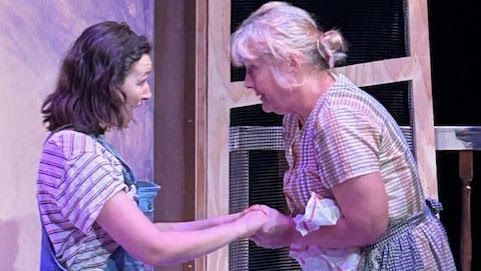SALT LAKE CITY – I am a big fan of Pygmalion Productions and their mission of “giving artistic voice to women.” Their latest production, Tender Hooks¸ by local playwright Julie Jensen and director Fran Pruyn, does indeed support that mission. Although Tender Hooks is not the strongest show Pyg has put on, it did leave me with some things to think about, as does almost everything I’ve seen from the company.
To Pygmalion’s credit, the company is unafraid of tackling original work. The play centers on the character of La Priel, an elderly widow played delightfully by Jensie Anderson. La Priel’s small rural world is steeped in routine and habit and is upended by the arrival of her new neighbors, their many children, and what she considers their uncouth and unfamiliar ways. The play explores themes of society’s long history of othering people who look and act differently from what may be accepted as “normal”. It weaves in reminders of the humanity we all share and ways in which we aren’t that different at all—themes that are extremely relevant and important right now.
The term “tender hooks” is a common mishearing of the idiom “tenterhooks.” A tenter is a wooden frame upon which fabric is stretched, preventing shrinkage. The tenterhooks are the metal hooks used to hold the cloth to the frame. Thus tenterhooks implies a feeling of being stretched with stress or tension—which La Priel definitely is throughout the play. Tender hooks, on the other hand, is a fairly meaningless juxtaposition of two unrelated and rather oppositional words, although the phrase does offer some interesting potential meanings. It suggests a tenderness that slowly develops between the diverse characters, as well as the hooks of relatable experiences that help La Priel begin to realize she may have more in common with her new neighbors than she thought. At one point, La Priel sagely says that it is a blessing “to let go of what cannot be held.” Which is profoundly true of all the exhausting preconceptions and prejudice we tend to cling to, and speaks to the release of tension to be found in finding commonality and letting go of that which doesn’t serve us.

Jensen’s bio in the program notes that this is her favorite of her works, which is clear in the tenderness with which the playwright treats the dialogue, characters, and relationships. There is endearing development of relationships in the script as La Priel’s perfectly tidy world is disturbed by the whirlwind of her neighbors. However, the script lacks a substantive conflict to drive the plot and support the development of the relationships. Jensen also mentions that the play was expanded from a one-act play, but it stills feels much like one, coming in at just over an hour. Surprisingly, even in that short time, some scenes feel overly long. There is a lot of expository dialogue and relationship development before the script finally gets meatier as La Priel finds commonality in a surprising scene with Mrs. Hicks, played by Brenda Hattingh. This interchange drew me deeper into the world of the play and made me start to care about these characters. Unfortunately, this occurs just before the end of the play. This abruptness feels less like a distinct choice to leave loose ends in the plot for contemplation and more like underdevelopment.
Pruyn’s direction was fairly clean and balanced, yet the pacing was very slow, at times dragging uncomfortably and highlighting the plot’s shortcomings. There were two interchanges in the beginning and end of the play where monologues cleverly interweave together; yet there was so much space in each that it felt like the actors were waiting on each other rather than successfully executing an overlapping narrative.

Anderson is clearly the strongest of the cast, and La Priel’s character arc in her capable hands is very touching. Addie Bower’s Letha, the 11 year old girl who functions as a bridge between La Priel and the new family, is also strong and I was excited to see her return to the Pyg after a moving performance as Joan of Arc in their recent production Mother of the Maid. Jane Huefner as La Priel’s sister Margery and Hatting as neighbor Mrs. Hicks offer solid supporting roles, with some particularly tender moments at the end by Hattingh.
The technical aspects of the production are good—the set design by Allen Smith uses a thrusting angle to put the porch front and center, where a lot of the uncomfortable interaction between the La Priel and her neighbors occur—its awkward shape echoing the awkward conversations taking place thereon. The odd angle and placement makes the stage feel off-balance, with a heavy, realistic kitchen on one side, juxtaposed with the empty outside, beyond the porch into the unknown world of the neighbors. The lighting design by Kai Sadowski utilizes an upstage cyclorama screen effectively to suggest mood and time. I did find the lighting effects during scene transitions to be somewhat confusing, suggesting more time was passing than necessary. This lack of clarity is distracting and doesn’t seem to support the story.

Tender Hooks contains some clever moments of dialogue, delicate attention to relationships, and solid acting throughout the short production. To audiences looking for a well-developed, conflict driven plot, this is not it. But for those interested in a thoughtful, character driven play, and in supporting Pygmalion and their dedication to highlighting local talent, developing new work, and uplifting women’s voices, this production fits the bill.





